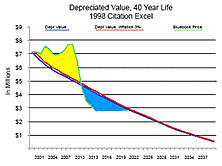Contributed by Doug Kvassay, Aircraft Sales Representative
If the major banks followed a "reverse-loan" policy, we would see less volatility in aircraft prices.
Click to enlarge.
In a previous blog posts, I discussed how the depreciated value of a business aircraft compares to its market value over time and that there is usually a difference between these two values. The depreciated value is the worth of an aircraft based upon a predetermined depreciation schedule over the entire life-cycle of the aircraft until retirement.
Bank Lending Practices During Economic Swings
During times of economic prosperity, aircraft trade for far more than their estimated depreciated value. This is when banks are comfortable lending 90 to 100% of the aircraft’s current market value on an asset-based only loan, with longer than normal terms.
Conversely, when the economy has contracted resulting in a recession, aircraft market values fall below their depreciated value and banks become extremely restrictive when making new loans. While considering new loan parameters in this adverse environment, banks are haunted by the declining values of the assets backing their current loan portfolio. Now banks want shorter terms, larger down payments, and more collateral, sometimes beyond the asset itself.
These lending practices have banks lending too much money when asset values are inflated and restrict lending when there is little risk of further asset devaluation. This is actually the opposite of what the banks should be doing. I credit much of this problem to the current valuation process when making loans.
Current Business Aircraft Valuation Process
In order to get “current” market values for business aircraft, banks pull numbers from one or both aircraft pricing guides (Vref Aircraft Value Price Reference & Aircraft Bluebook Price Digest) and then may hire an “outside expert” to validate the numbers in these guides. Their due diligence for valuation is based solely on the last three months of pricing data. However, this information provides little insight into what an aircraft should be valued at when looking at the larger picture of values over the asset's entire life cycle.
A bank should consider the lifetime values of an aircraft. For example, when the aircraft is trading for $7 mil, but the depreciation model shows it to be a $5 mil asset, as the graph for a 1998 Citation Excel shows, banks should require a larger down payment, shorter loan terms and more collateral. This tightening of credit terms would dampen the rapid price inflation we have seen in the past.
Likewise, in a downturn, when the asset is selling for less than $3 mil, but its depreciated value is closer to $4 mil, the banks could loosen loan requirements, providing more liquidity to the market and help drive prices up to where they should be.
If the major banks followed these reversed loan policies, we would see less volatility in aircraft prices and in the collateral backing up their loans. There will always be the financing institutions that will continue to follow current policies, but when the economy turns, as it always does, they will be burdened as many banks are today and many smaller institutions will fall to the wayside.
Duncan Aviation has helped clients buy and sell aircraft since 1956, and has facilitated more than 3,000 transactions in several different countries. For the latest aircraft sales listings, visit www.DuncanAviation.aero/aircraftsales.
Doug Kvassay is a part of a team of four Aircraft Sales Representatives. He specializes in advanced aircraft aftermarket analysis and managing complex transactions. His aviation career began in 1980.



